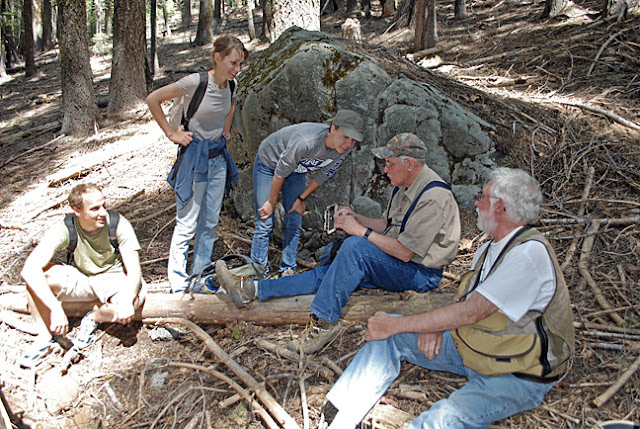 |
| (left to right) JR Blair (SNFC Director), Audrey Nickles, Lissa Derugin, Bill Wilson (SNFC alumnus), Chris "Codger" Wemmer, Sebastian "Seabass" Kennerknecht, and Carl "Montana" Hansen" |
Monday morning started with a lecture on camera trap sets, followed by a field demonstration on making a set (i.e., selecting of a site and positioning the camera).
 |
| Seabass demonstrates his set using a DSLR and external flashes |
After that, the class made their own sets and I kibbitzed.
That afternoon we started checking the camera traps set last month.
Back in June five of last year's class joined me in setting cams for the workshop.
So instead of the 4-5 cams I usually set by myself, we had 12 cams waiting for us.
We puffed our way up a hill to a log set among red firs, and we found a long series of pine marten photos waiting for us.
My old buddy Carl suggested I'd "cooked the results".
Those two photogenic martens had posed superbly, and I did lay it on rather thick as I scoped out each successive shot.
In addition to the daily routine of exploration, and setting and checking cams, we spent the evenings re-hacking one of Carl's cameras, photographing flying squirrels at a feeder, and getting the analog-digital converter to work with my new "gopher cam".
We'll talk about the latter -- a "burrow scope" for snooping in tree cavities and underground dens -- in a future post.
 |
| Carl got the Codger's "gopher cam" working. |
Later in the week we forded the North Yuba at a log jam to explore the wonders of talus and giant red firs.
"Okay, troops, tell me the size of this tree".
Earlier in the week we had measured one with a 15 foot circumference, so again I dug the tape measure out of my pack.
This one measured in at 17 feet, and the two best guesstimates were only off by a foot.
Seabass then drew our attention to a cavity on the other side of the old veteran.
It was a respectable cavity with a vertical hollow of unknown length.
There was enough space in there for a coyote or even a few bear cubs.
A perfect cone of frass inside announced an infestation of wood ants, but as ants go they were friendlies,
We all agreed it was a good place to set a camera.
The class conferred on what kind of set to make, and settled on a Jonah set (in the whale's belly).
Lissa crawled in, set the cam, and took a self portrait.
In a few weeks we'll have a camtrappers' rendezvous to see if anything visits the hollow in the old giant, or if the showtls passed our subterranean cams.









4 comments:
Looks like you had a wonderful time! Looking forward to seeing more of your captures!
JoEllen Arnold
Class of 2010
FYI, the cavity at the base of the tree looks like a bear den. All of our natal dens were in similar situations in the Marbles and Sierra's. I have an almost identical image of one of my sons crawling out of one of the natal dens in summer. Need to get the slide scanned.
Bob
Thanks for the awesome week Codg! Learned a great deal. That's also really cool about the Bear den, would love to see your slide Bob!
Yes, Thank you Codg for teaching a small group! Learning about cam.s was very helpful, but learning about the mammals in the Sierras has really inspired me to pursue mammalogy. Are we going to be able to get the camera out of the Whale’s Belly without Lissa?
Post a Comment